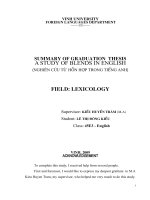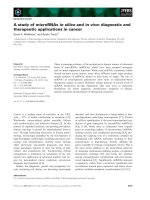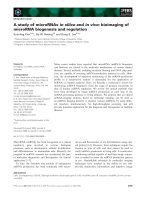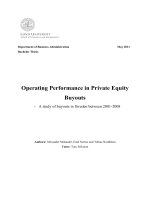A study of major sources of borrowings in english vocabulary = nghiên cứu những nguồn vay mượn chính trong từ vựng tiếng anh
Bạn đang xem bản rút gọn của tài liệu. Xem và tải ngay bản đầy đủ của tài liệu tại đây (774.59 KB, 48 trang )
HANOI PEDAGOGICAL UNIVERSITY 2
FOREIGN LANGUAGE FACULTY
HOÀNG THỊ MINH HẢO
A STUDY OF MAJOR SOURCES OF BORROWINGS
IN ENGLISH VOCABULARY
(NGHIÊN CỨU NHỮNG NGUỒN VAY MƯỢN
CHÍNH TRONG TỪ VỰNG TIẾNG ANH)
Field: English Linguistics
HA NOI, 2019
HANOI PEDAGOGICAL UNIVERSITY 2
FOREIGN LANGUAGE FACULTY
HOÀNG THỊ MINH HẢO
A STUDY OF MAJOR SOURCES OF BORROWINGS
IN ENGLISH VOCABULARY
(NGHIÊN CỨU NHỮNG NGUỒN VAY MƯỢN
CHÍNH TRONG TỪ VỰNG TIẾNG ANH)
Field: English Linguistics
SUPERVISOR: ĐỖ TIẾN ĐỨC, MA
HA NOI, 2019
ACKNOWLEDGEMENTS
I would love to show my huge and sincere gratitude to my supervisor, Do Tien
Duc for his patience, guidance and support throughout the time I carried out my
thesis, without whom this project would not have been completed. I would also like
to thank all both Vietnamese and foreign teachers of English at Hanoi Pedagogical
University No.2 for their guidance and advice during the time I did the study.
I am also grateful to my family and friends who always stand by me in any
situation to help me go over many troubles and difficulties through the course.
i
ABSTRACT
The study focuses on how some languages have affected English by
specifically pointing out the major sources of borrowing of English vocabulary f rom
each language. In detail, it fully deals with how words in English has been
borrowed from some other languages and paves the ways for readers to be able to
recognize loan words or borrowings in newspapers. The study is done with the
process of collecting a lot of data, synthesizing and analysing the materials in
specific method to bring about reliable findings which are the four major sources of
borrowings in English vocabulary from Celtic, German, Latin and French, along
with the identification of loan words from these languages used in English
newspapers. The research hopefully meets the needs of discovering English
language by readers and makes contributions to the development of language study
in general and learning English in particular.
ii
DECLARATION
I hereby certify that the thesis entitled:
A study of major sources of borrowings in English vocabulary
Is my own study in the fulfilment of the requirement for the degree of
Bachelor of Art at Hanoi Pedagogical University No.2. The study is the result of
hard – working time by the enthusiastic guide of my supervisor and other people.
Student
Supervisor
Hoang Thi Minh Hao
Do Tien Duc
iii
LIST OF TABLES AND DIAGRAMS
Diagram 1: Germanic languages (Barber, C., 1993, p.34)
Diagram 2: North Germanic languages (Barber, C., 1993, p.35)
Diagram 3: West Germanic (Barber, c., 1993, p.35)
Diagram 4: East Germanic (Barber, C., 1993, p.36)
Table 1. Abbreviations of borrowings)
Table 2: Borrowings used in the extract)
iv
TABLE OF CONTENTS
PART I: INTRODUCTION ............................................................................................1
1. Reasons for the study.................................................................................................1
2. Aims of the study ........................................................................................................1
3. Research questions .....................................................................................................1
4. Scope of the study .......................................................................................................2
5. Methods of the study .................................................................................................2
6. Organi zation of the study .........................................................................................2
PART II: DEVELOPMENT ...........................................................................................3
CHAPTER 1: LITERATURE REVIEW .....................................................................3
1.1.
Native words and borrowed words....................................................................3
1.1.1. Native words .........................................................................................................3
1.1.2. Borrowed words...................................................................................................4
1.2. Motivation of borrowings .....................................................................................4
1.2.1. Non-linguistic causes...........................................................................................4
1.2.2. Linguistic causes ..................................................................................................5
1.3. Assimilation of borrowings...................................................................................6
1.3.1. Definition ...............................................................................................................6
1.3.2. Types of assimilated words................................................................................6
1.4. Classification of borrowings in English vocabulary .......................................7
1.4.1. In terms of the history of English borrowings ..............................................7
1.4.2. In terms of the manner of borrowings............................................................9
1.5. Summary ............................................................................................................... 10
PART II: DEVELOPMENT ....................................................................................... 11
CHAPTER 2: MAJOR SOURCES OF BORROWING IN ENGLISH
VOCABULARY.............................................................................................................. 11
2.1. Celtic borrowings .................................................................................................... 11
2.1.1. The Celtic language and its influence on the English vocabulary ............ 11
2.1.2. Celtic borrowings- clues in place names......................................................... 12
2.2. Germanic borrowings ............................................................................................ 13
v
2.2.1. A brief overview on the history of the German languages ......................... 13
2.2.2. Germanic borrowings ......................................................................................... 16
2.3. Latin borrowings..................................................................................................... 21
2.3.1. Historical contexts that lead to the borrowing of Latin word ................... 21
2.3.2. Classification of Latin borrowings in English vocabulary ......................... 23
2.4. French borrowings.................................................................................................. 25
2.4.1. The Norman Conquest's influences on the English language .................... 25
2.4.2. French borrowings .............................................................................................. 26
2.5. Summary................................................................................................................... 29
CHAPTER 3: EXAMPLES OF BOROWINGS USED IN ENGLISH
NEWSPAPERS ............................................................................................................... 30
3.1. Introduction ............................................................................................................. 30
3.2. Signs of borrowed words in copy ........................................................................ 30
3.2.1. Italics ...................................................................................................................... 30
3.2.2. Accent and other marks ..................................................................................... 30
3.2.3. Plurals..................................................................................................................... 31
3.3. Abbreviations ........................................................................................................... 31
3.4. Signs of borrowed words ....................................................................................... 32
3.5. Sample article: the extract of “Radicals in Retreat” – by Conant............... 33
3.6. Summary................................................................................................................... 36
PART 3: CONCLUSION .............................................................................................. 37
1. Review of the study ................................................................................................. 37
2. Suggestion for further studies .............................................................................. 37
REFERENCES
APPENDIX
vi
PART I
INTRODUCTION
1. Reasons for the study
It is true that both English native speakers and non-native speakers can easily
realize a lot of same words or same-looking words when they compare English and
another languages like French or Latin. This is because of the fact that English has a
close relationship with other languages. In other words, English vocabulary contains
a variety of borrowings from various source languages. However, it is very difficult
for those studying English to recognize which words are borrowed ones, and which
source languages these borrowings originally belong to. The researcher herself also
finds borrowings a hard subject. However, it is also the matter she is interested in
most because it is difficult but interesting and useful for the study. Last but not
least, during her study at Hanoi Pedagogical University No.2, the subject has not
been seriously touched upon yet. All of the reasons above have encouraged her to
choose the subject on borrowings as her thesis for graduation.
All the studies of English vocabulary so far have not clearly identified the major
sources of borrowings in English vocabulary. This encourages me to carry out a
study about this as a way to discover from which other languages, a big part of
English vocabulary originates.
2. Aims of the study
In this study, the researcher would like to give an overview of the following issues:
The generalizations about English borrowings
The major sources of borrowing that have the most influence on
English vocabulary
3. Research questions
The study aims to deal with the following research questions:
1. How was English vocabulary borrowed from other languages in
the history of the English language?
2. What are some major sources of borrowings in English
vocabulary?
1
4. Scope of the study
There are many languages that have contributed words to English vocabulary. It is,
however, due to the lack of time as well as experience, in this graduation paper I
only focus on the major sources of borrowings that have the most influence on
English vocabulary, namely Celtic, Germanic, Latin, and French.
5. Methods of the study
As this study is a theoretical-based one, the researcher collected materials and
information as data related to sources of borrowings in English vocabulary, as well
as synthesized and analysed them to have an overview of the research topic. Then
all the detailed information is theoretically studied to get the results of how English
vocabulary has been borrowed from other languages and major sources of these
borrowings.
6. Organization of the study
The thesis consists of three parts: the introduction, the development and the
conclusion.
Part 1: The introduction gives the reasons for the study, history, research questions,
aims, scope and methods of the study. It also shows the organization of the study.
Part 2: The development consists three chapters.
Chapter 1 deals with the general knowledge about English borrowings.
Chapter 2 works on the major sources of borrowings in English vocabulary.
Chapter 3 mentions some (suggested) ways of identifying borrowings in English
newspapers.
Part 3: The conclusion presents a review of the study as well as suggestions for the
further studies.
2
PART II
DEVELOPMENT
CHAPTER 1
LITERATURE REVIEW
1.1.
Native words and borrowed words
English is considered as a multiple-characteristic language in the world. One of the
most common characteristic is the influence of foreign elements in itself. Besides,
many linguists supposed that English language system which contains grammar and
phonetic system is very stable and difficult to be changed by any influence. By
considering the usage of different sides and many components of borrowed
elements in enriching English vocabulary, people see the basement and the full
development of English vocabulary. Basing on the origin of words, they can be
divided English vocabulary into two layers: native words and borrowed words (or
loan words or borrowings).
1.1.1. Native words
Native English words are words of Anglo-Saxon brought to the British Isles in the
fifth century by the Germanic. They are subdivided into the Angles, the Saxons, and
the Jutes.
Surprisingly, this layer of words takes up only about 30% of the whole -English
vocabulary (Truong, H. T., 1995, p. 101) but mostly makes up the basic stock of
words- the foundation and the score of the English vocabulary. They denote the
most common objects and phenomena of nature (e.g. sky, earth, sun, star, rain,
wind, tree…), name of human beings (e.g. man, woman, mother, father, arm,
foot…), actions of everyday life (e.g. eat, drink, do, make…), or primary qualities
and properties (e.g. big, small, good, bad, cold, hot…) and so on and so forth.
Native words have been undergoing considerable changes, that is, new words or
new meanings of old words appear while some old words or meanings are no longer
used or even drop out of the language entirely. However, as we have mentioned,
they mostly establish the underlying stock of words, so they are considered most
stable, most significant for the communicative purposes.
3
1.1.2. Borrowed words
Borrowed words are words borrowed from other languages (the source languages).
The may be completely or partially assimilated in the English vocabulary and take
up approximately 70% of the total.
Distinguishing between borrowings and loan words is necessary. A borrowing can
be considered as a loanword. Borrowing is the process of adapting words from a
foreign language to native language. "Loan" and "borrowing" are not literal terms
that those who use different languages from their own mother tongue defined. It is
advisable for her to use the word borrowing(s) throughout this graduation paper.
English has come through many time periods in which a large number of words
from other languages affected in it. These periods occurred at the same time with
periods of main cultural interference between English native speakers and those
speaking many foreign languages of which Latin, Germanic, Celtic and French
stand out as the major contributors, which, of course, have greatly influenced on the
English vocabulary. Apart from these significant sources of borro wings in the
English vocabulary, Italian, Greek, Dutch, Spanish, Portuguese, Arabic, Russian,
Persian, Japanese, Chinese and so forth have also done their part in the development
of Modern English vocabulary.
It is also necessary to distinguish between “source of borrowings’’ and “origin of
borrowings’’. It is commonly accepted that “source of borrowings’’ is the language
from which some words were borrowed in English. On the contrary, “origin of
borrowings’’ is the language to which this word belongs or can be traced. For
example, the word paper was borrowed from French, but its origin is Greek.
1.2. Motivation of borrowings
1.2.1. Non-linguistic causes
English words may be borrowed through various contacts between Britain and other
countries. These contacts may have been through business, wars, periods of peace,
culture and so on. Among these, wars, including invasions and occupations, stand
out as the primary cause that stimulates the borrowing process. It is because during
invasions and occupations the natural psychological reaction of the oppressed
4
nation is to reject and condemn the language of the oppressors. However, the
Norman Conquest (1066) seemed to be an exception since Norman’s level of
civilization was much higher than that of the British, and the Norman culture of the
eleventh century was likely superior to that of the Saxons. The impact of the
Norman Conquest on the English language like that made by the earlier Norse speaking invaders was primarily confined to the word stock. As a result, an
immense body of French language was finally adopted to turn into a part of English
language system.
Despite the dominant interference of the foreign elements, the English language
system has enrichened by adding a lot of new borrowings.
1.2.2. Linguistic causes
It is hugely inadequate if we only mention the non-linguistic causes of borrowings
into English. A large number of English words are also borrowed under the
necessity of new linguistic demands. Firstly, as we can see, Britain once
experienced a variety of invasions. These invaders brought them words conveying
the meanings of new things, ideas, notions, etc., which led to the necessity to name
them. For instance, Normans and Romans who used to occupy Britain for a long
time brought words like street, cheese, court, army, and state…to this country and
they have been used ever since. Secondly, the cause can be traced back to the
Renaissance in England that because of technology development, huge demand of
discovering the world and printing techniques, more books written by Latin
languages became popular. To widen the number of readers, people change it into
English and kept some special Latin words. Examples of Latin borrowings include
benefit, exist, virus, fact, explanation, eradicate… Last but not least, it was also
necessary to replace a word group denoting one object or idea by a single word. For
example, “the ground of school or college’’ was replaced by the Americanism
“campus’’. In short, these reasons can thoroughly explain why English has been
keeping borrowing words from other languages to enrich its extensive vocabulary.
Usually, borrowings are due to the combination of both linguistic and non-linguistic
factors.
5
1.3. Assimilation of borrowings
1.3.1. Definition
Assimilation is the combination of the phonetic, graphics, grammatical, and lexical
rules of the receiving language.
1.3.2. Types of assimilated words
According to the degrees of motivation (Truong, H.T., 1995, P. 57), there are three
groups: completely assimilated words, partially assimilated words and completely
non-assimilated words.
1.3.2.1. Completely assimilated words
Completely assimilated words are usually old borrowings. Most of them are
frequent and stylistically neutral words. They make a significant contribution to
word-formation in English.
e.g., cheese, wine, street, etc. (Latin)
Husband, fellow, happy, etc. (Scandinavian)
Table, face, finish, etc. (French)
It can be hard to distinguish a great deal of completed assimilated words from
native words because all the words of this group follow all the phonetic,
grammatical, and lexical rules of the English language.
1.3.2.2. Partially assimilated words
This group of words can be subdivided into four types as follows:
•
Grammatically non assimilated words are usually words that keep their original
plural forms.
e.g., crisis – crises
Index – indices
Phenomenon – phenomena
•
Semantically non – assimilated words are words that denote objects, notions
peculiar to the country from which they come.
e.g., kimono (Japan), sheik (Egypt), kangaroo (Australia)
•
Phonetically partially – assimilated words
-
With the stress on the final syllable:
6
e.g., police, cartoon, prestige, etc.
-
With the whole different pattern:
e.g., potato, opera, tomato, etc.
-
With alien sound:
e.g., bourgeois, memoir, etc.
•
Graphically partially – assimilated words:
e.g., café, fiancé, ballet, etc.
1.3.2.3. Completely non – assimilated words
Completely non – assimilated words are words used by the English in both spoken
and written forms. There are usually English equivalents for them.
e.g., coup (or coup d’etat): a sudden seizure of state power.
1.4. Classification of borrowings in English vocabulary
To classify borrowings in English vocabulary, linguists usually base on such
different criteria as the origin of borrowings, the history of English borrowings, the
manner of borrowings and so on. However, within the framework of this graduation
paper it advisable to deal with only the classification of borrowings in English
vocabulary regarding the history of English borrowings and manner of borrowings
as follows.
1.4.1. In terms of the history of English borrowings
The remarkable thing is the fact that English acquired some words from Latin
before the Angles, Saxons and Jutes came to English and brought English a number
of Germanic dialects. However, as what is left today, the number of word is counted
under a hundred (e.g., wall, street, cheap, wine…), therefore could be declared that
Old English was majorly made by Germanic. As a result, loanwords in this stage are
not as much as borrowed words in Middle English and Modern English. It is
estimated that only 30% of Old English vocabulary contained loanwords, whereas
the figure is 70 % in today’s English vocabulary.
This brief historical summary of English borrowings helps lead us to the
classification of borrowings in English vocabulary into Old English (OE), Middle
English (ME) and Modern English (Mod. E).
7
1.4.1.1. Old English
Old English belongs to the period that lasted from AD 450 to 1100 when the Anglo
– Saxon rulers were defeated by the Norman invaders under William the Conqueror.
As it has been mentioned, the main of borrowings in OE were originally Latin.
Latin has had huge role in almost fields in the society, especially in widening
people’s literacy. This period also saw the mixing of Anglo – Saxon with
Scandinavian languages (Old Norse and Old Danish), the language of the Viking
invaders.
1.4.1.2. Middle English
Middle English is the name of other periods of language borrowings from 1066 (the
Norman Conquest) to 1500. The Norman Conquest in 1066 exercised a major
influence on the English language because French was an invading language or the
official language of law and administration. As the language of the aristocracy and
of almost all official bodies, French might conceivably have replaced English at that
time. This period saw the flood of French words entering the English vocabulary.
As William Johnson (1984, p. 454) points out that over 10,000 words were adopted
from French during ME period. Examples of French borrowings include
parliament, government, judge, jury, beauty, romance, and many others. However,
English always remained the speech of the common people, and in its struggle for
survival, strengthened its resources by, as we can see, absorbing approximately
10,000 words from French and innumerable other words from Latin.
1.4.1.3. Modern English (from about 1500 to the present)
This period can be roughly subdivided into Early Modern English (1500 – 1800)
and Late Modern English (1800 – present day). The Early Mod. E was said to be the
period of extensive borrowings, particularly from Latin and Greek. At times,
borrowings even displaced English words. The influx of strange words and their use
In English sentences caused a reaction of distaste among writers of the seventeenth
century. The denounced “inkhorn’’ terms – their phrase for obscure and pedantic
words like accersited for “brought’’ and adjuvate for “aid’’, both derived from
Latin. A few words were also borrowed from Italian and Spanish. The Italian
8
borrowings include words to do with warfare (fuse, salvo, squadron…), with the art
(opera, fresco, madrigal...) and with commerce (argosy, artichoke…) and so on.
Besides, Spanish loans, too, are often concerned with warfare (cargo, sherry…)
(Barber, Beal, & Shaw, 2009). Meanwhile, Late Modern English saw the spread of
English around the globe, the development of overseas colonial dialects and the
massive increase in vocabulary under the influence of technology and scientific
achievements.
1.4.2. In terms of the manner of borrowings
1.4.2.1. Doublets
Doublets are words originating from the same source but differing in phonemic
shape and meaning. For example, the words shirt and skirt etymologically descend
from the same root. Shirt is a native word, and skirt is a Scandinavian borrowing.
Their phonemic shape is different, and yet there is a certain resemblance, which
reflects their common origin. Their meanings are also different but easily
associated: they both denote articles of clothing (Студопедия, 2015).
1.4.2.2. Hybrids/loan – blend
Hybrids/loan – blend are words which borrowed for a long past time but these are
now changed into half-blood words English language. They are usually words made
up of two parts each from a different language such as sociology (a French element
socio + a Greek element – logy), and hydroplane (a Greek element hydro + a Latin
element – plane).
1.4.2.3. Aliens
Aliens are words that borrowed from foreign languages but still maintained their
own rules of spelling and pronunciation. These words can be immediately
recognized – for example, automobile, café, garage are all aliens from French.
1.4.2.4. Translation – loans
Translation – loans are words and expressions borrowed from a foreign language
utilizing translation. Such words can be translated accord
ing to the meaning as
well as the sound. They may be translations of the whole phrase of it, or morphe me
– by morpheme, or even words – by words.
9
e.g., skyskraber (Danish) – skyscraper (Mod. E)
humor noir (French) – black humor (Mod. E)
1.4.2.5. Semantic loans
Semantic loans are words that have obtained new connotation under the impact of
different language. In other words, English has borrowed a new meaning for an
existing word in the language. Semantic loans are also called Meaning Extensions.
The Old English word gift meant “the price of wine’’ while in the Scandinavian it
means “present’’. It can say that the word gift has had new connotation under the
impact of the Scandinavian language.
1.5. Summary
In this chapter, I have generalized the borrowings in English vocabulary. It includes
certain aspects of borrowings such as definition, motivation, assimilation, and
classification of borrowings in English vocabulary.
10
PART II
DEVELOPMENT
CHAPTER 2
MAJOR SOURCES OF BORROWING IN ENGLISH VOCABULARY
2.1. Celtic borrowings
2.1.1. The Celtic language and its influence on the English vocabulary
Why Anglo – Saxon culture and language spread swiftly across east and central
Britain during the sixth and the seventh centuries, corners of the Isles retained the
languages of the previous dominant culture, the Celtic people who are believed to
have begun arriving in the Isles around 600 BC. In fact, the Celts had huge impact
on people of German and almost central Europe. For instance, though their
languages did not became an official one in Europe, Latin which was changed by
the Celts was still used frequently.
However, instead of unifying with Celtic people, the Anglo - Saxon againsted them,
therefore, Celtic dialects could not go over its border until a language system was
built by the influence of the Norman Conquest. Linguistically, Celtic languages are
divided into two branches, namely Goidelic (or Gaelic) and Brythonic (or British).
The Goidelic languages consist of Irish, Highland Scottish and Manx. The
Brythonic is made up of Welsh, Cornish and Breton. Of these languages, perhaps,
Welsh is the one to survive most strongly in the present day, mainly due to the
efforts of the Welsh managing to preserve their culture and identity part from the
English (Lovis, 2001).
Celtic borrowed words in English have gradually disappeared because the stigma of
British community to it thousand years ago. This language became weaken and left
a few traces in geographical words and place names (the latter will be discussed
more in the following part).The survival of the Celtic language has been a matter of
pride, and they have survived mainly where numbers were large enough to enable
its survival though everyday usage, as well as having their importance emphasized
through the establishment of a body of literary work. Unfortunately, the various
branches
became
geographically
isolated,
11
preventing
any
opportunity
at
standardization as an alternative to the centralized English social and political
structure (Lovis, 2001).
2.1.2. Celtic borrowings- clues in place names
According to Jonathan Culpeper (1997, p.1), the most important factor in the
development of English has been the arrival of successive way of invaders and
settlers speaking different languages. The history of place names in Britain is
closely connected to the dominance of languages at various points of time.
As we have mentioned, long before the Germanic tribes arrived in Britain. Briton,
one of the common Celtic clans has owned this land. For generations, the language
of the Celts was referred to as “British”. Even though, the influence of Celtic in
English language is not much and has partially traces in place names:
-
Cities: Belfast, Dublin, Glasgow, London, York
-
Rivers: Avon, Clyde, Dee, Don, Forth, Thames, Darent, Dart
-
Regions: Argyll, Cumbria, Devon, Dyfed, Glamorgan, Kent, Lothian
We cannot be sure what these place names might originally mean because, like
many other place names, they predate written records, which are preserved in
significant quantities only from about 700 AD. More specific, conjecture is also the
way of studying the development of place names by putting these words (Celtics or
Welsh) in comparison or infers hints in text. Thus, people can roughly guess the
meanings of the following place – name elements.For example, Pen (Welsh pen) =
top, hill (e.g. Pendock, Penrirth); Bar = wooded hill (e.g. Barnet).
In some studies, especially one by Charles Barber (1993), linguists have tried to
explain the meanings of a few existing Celtic place names today. For example, Avon
and Ouse are Celtic words for ‘water’ and ‘stream’; Darent and Dart are all forms
of British names for ‘oak river’; the Thames is the ‘dark river’ (Barber, Beal, &
Shaw, 2009). Meanwhile, such region names as Kent and Devon are Celtic, and so
are the first elements in Cornwall and Cumberland, the latter means ‘the land of the
Cymry (that is, the Welsh) (Barber, Beal, & Shaw, 2009).
Apart from those place names, a number of names are compounds of Celtic and
Anglo – Saxon words (Lovis, 2001). Two Celtic words for ‘hill’ bre and pen appear
12
in a number of names – for instance, Brill in Buckinghamshire is a combination of
bre and dun; Pensax in Herefordshire means ‘hill of the Anglo – Saxons’ giving an
indication of the proximity but isolation in which Celtic communities would have
existed until they were gradually pushed to the corners of Britain by the Anglo –
Saxons (Lovis, 2001).
In short, though the contribution of the Celtic languages to the English language
seems disproportionate to the importance and longevity of the Celtic culture within
British society overtime, it is important to remember that the place names, which
have been created, are still an useful reminder of the ways in which past society
viewed their surroundings. In addition, the names they chose feature the
characteristics of the land as those who lived during that time observed it.
Moreover, the failure of Celtic to influence Old English to any great extent does not
mean that the Britons were all killed or driven out (Lovis, 2001). Today the people
who inhabit those areas take a pride in preserving the Celtic language, mainly
surviving in place names, as a way of protecting their heritage (Lovis, 2001).
2.2. Germanic borrowings
2.2.1. A brief overview on the history of the German languages
The part of Indo – European language that English borrowed from is defined as
Germanic. It contained five units: German, Frisian, Dutch, Swedish, and
Norwegian. These five languages are subdivided by a couple of language which is
Proto- Germanic, one of common dialects of Indo-European. Proto – Germanic
dialects were increasingly noticed when the number of people who spoke Germanic
was expanded. Hence, it is easier to determine three arms of dialect family
consisting North Germanic, East Germanic, and West Germanic as illustrated in the
following tree:
13
Proto-Germanic
North Germanic
East Germanic
West Germanic
Diagram 1: Germanic languages (Barber, Beal, & Shaw, 2009, p. 87).
2.1.1.1. North Germanic
North Germanic belongs to the modern Scandinavian languages including
Norwegian, Swedish, Danish, Icelandic, Faroese, and Gutnish. People found the
first signal of North Germanic in about 300-AD runic inscriptions. It was not much
trace of dialectal diversity until the Viking Age (from about 800 AD onwards)
affected in dialects. From then, it rapidly has developed into the modern
Scandinavian languages. Below is a family tree for the North Germanic languages
(Barber, Beal, & Shaw, 2009).
North Germanic (Old Norse)
West Scandinavian
Icelandic
Norwegian
East Scandinavian
Faroese
Danish
Swedish
Gutnish
Diagram 2: North Germanic languages (Barber, Beal, & Shaw, 2009, p. 88).
2.2.1.2. West Germanic
This group belongs to the High German dialects of southern Germany, the Low
German dialects of Northern Germany (which in their earliest recorded forms are
called Old Saxon), Dutch, Frisian, and English
(Barber, Beal, & Shaw, 2009).
Among these languages, Frisian seems to be most closely related to English because
it is said that before the Anglo – Saxons migrated to England, they had been near
the neighbors of the Frisians. However, in this group, it is the High German and the
14
Low German that make the greatest contribution to the borrowing process in the
English vocabulary. The below diagram is a family tree for the West Germanic
languages.
West Germanic
High German
Modern
Anglo – Frisian
Low German
Yiddish
English
Frisian
Standard
German
Dutch
Ajrikaans
Modern Low
German (Plattdeutsch)
Flemish
Diagram 3: West Germanic (Barber, Beal, & Shaw, 2009, p. 90).
2.2.1.3. East Germanic
East Germanic dialects were spoken by the tribes that expanded of the Oder around
the shores of the Baltic. They included the Goths whose Gothic is the only one East
Germanic language that remains a few records today (Barber, Beal, & Shaw, 2009).
The main record of Gothic is the fragmentary remains of a translation of a Bible,
made by the bishop Wulfila in the middle of the fourth century (Barber, Beal, &
Shaw, 2009). However, all the East Germanic languages are now dead. In other
words, no East Germanic language has survived into our own time (Barber, Beal, &
Shaw, 2009). Yet, the Gothic is even now being studied by linguists for it is the
earliest written language in Germanic group. This chart shows clearer about East
Germanic languages.
15
East Germanic
Burgundian
Vandal
Gothic
Visigothic
Ostrogothic
Diagram 4: East Germanic (Barber, Beal, & Shaw, 2009, p. 89).
2.2.2. Germanic borrowings
2.2.2.1. Scandinavian borrowings
a. General knowledge about Scandinavian borrowings
Though the Scandinavian (Scan.) invasions of England are cited in Old English
stage, their effects on English vocabulary actually occur in written records in the
ME period. As a result, most of Scan. loanwords occured in this time by oral ways.
Many borrowed words were not used in text until few centuries later (the thirteenth
century).
The settlements of the Scandinavians in England resulted in a big amount of names
of places in the North and the East, the common of which are with Scan.
components. Consider the following examples:
Scan. Components
Meanings
Place names
-thorp
Village
Woodthorp
-toft
Piece of land
Brimtoft
-beck
Rivulet
Troutbeck
-ness
Cape
Inverness
Table 1: Common Scan. components
Indeed, the integration of the English and the Scan. settlers progressed rapidly; in
many districts, people became bilingual which was an easy accomplishment since
many of the most common words in the two languages were much alike.
16
At the beginning, the Scan. borrowings were limited because they leveled up the
degree of language diversity. Gradually, they penetrated into individual spheres of
the English language due to the mixed feature of the language, and then passed into
London English and the national language, as well. It is noteworthy that the number
of Scan. borrowings in the Northern dialects has always large than that in the
Midland or in theSouth. Probly, in ME there have been more Scan. words in current
usage that the survivals today. In regional language, there are dead words, there are
maintaining words (e.g. kirt means ‘church’ or daz ‘dew’). According to Thomson
Heinle (1993, p.293), the total number pf Scan. borrowings in English is
approximately 900 words.
It is very difficult to distinguish Scan. borrowings from English words. The reason
is that they are deeply penetrated into everyday English. The characteristics of Scan.
words are usually ordinary and has one syllable such as dirt, bank, birth, trust, egg,
fellow, knife, and so on. In other words, they are also are, they and their. In addition,
a good number of sc- or sk- words today are of Scan. origin e.g. scathe, score,
scowl, scarpe, scrub, skill, skin, skirt and sky.
Besides, a number of Scan. words have entered English during the modern period.
The best known of these are muggy, rug, scud, and ski, which are considered to be
dated from the later years of the nineteenth century. Other words like rune (1685),
saga (1709) and scald (1763) are all from Icelandic. The Swedish word ombudsman
meaning ‘official’ who looks into citizens’ complaints against government bureaus
and against other officials’ has as yet been lack of preference though it is entered in
recent dictionaries.
b. Changes in English vocabulary under the influence of Scandinavian
language
- The English word sometimes displaces the cognate Scan. word e.g. the sound sk,
which had been inherited from their Germanic ancestors, was soon changed to sh as
in fish instead of fisk.
- The Scan. word usually substitute the English word that has relation in origin to
Scan. language e.g. banana – banana (Scan.word).
17









